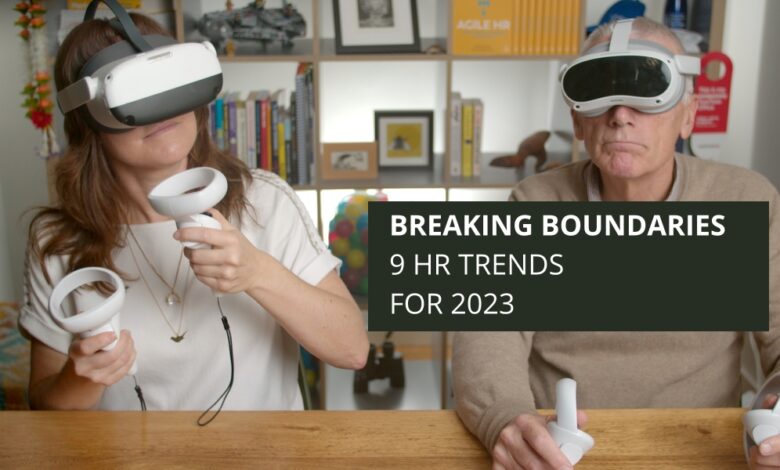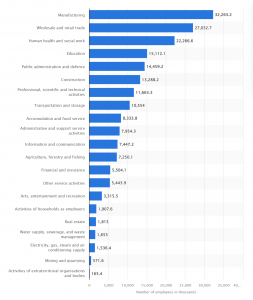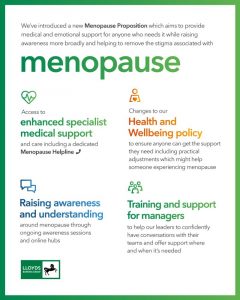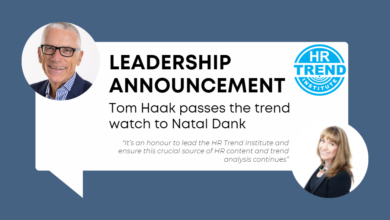
The HR Trend Report
The HR Trend Institute was founded in 2014 and in November every year for the last eight years we’ve published our top HR trends for the coming year.
2015: 9 emerging HR trends for 2015
2016: 11 HR trends for 2016
2017: 10 HR Trends for 2017
2018: 8 major trends for 2018
2019: 10 inspiring HR trends for 2019
2020: 12 HR trends for 2020
2021: 11 HR trends to take into account for 2021
2022: 10 HR Trends for 2022: From Adaptation to Transformation
The Megatrends that shape HR
Of course, the long-term megatrends don’t change every year. Below is an overview of our top 14 megatrends. Most of the trends for 2023 fit into one of these areas.
- From work for income to work as an expression of purpose
- From a collective to a personalised approach
- From technology as ‘nice to have’ to technology as a major transformational driver
- From slow to fast to faster > focus on current burning urgent issues
- From intuition and biases to evidence-based working., based on through analysis
- From rigid hierarchical organisations to an open ecosystem of networks
- From long-term plans to experimenting, using Agile and design thinking methods
- From pleasing the boss to creating a meaningful employee experience
- From learning in classrooms to learning in the flow of work
- From HR bureaucratic administration to client focused HR operations
- From job-based HR to skill-based HR
- From HR as advisers and bystanders to HR as activists
- From HR for the people on the payroll to HR for the ecosystem
- From submissive employees to independent co-creators
9 HR Trends for 2023: Breaking Boundaries
In 2023 it’s time for HR to break boundaries
- Your organisation needs it
- Your people need it
- Your communities need it
- And our planet needs it
We’re facing big challenges across society – the cost-of-living crisis, the war in Ukraine, business complexity, skill shortages, hybrid working and, of course, perhaps the most significant challenge – the need to fight climate change.
To respond to and help solve these complex problems, HR needs to work in multi-functional ways, collaborate and break down boundaries.
- Personal boundaries
- Functional boundaries
- And organisational boundaries
The pandemic has blurred the traditional boundaries separating our working lives from our personal, home, and social lives. We’re seeing a renegotiation of the employee-employer relationship. Increasingly, people seek a more human employment deal that requires a more holistic approach to the employee experience.
The world of work is rapidly changing, and a people-centric approach is crucial to business success. In 2023 we encourage HR professionals to stand up, call things out, lead by example and be the voice for people and our planet.
TREND 1
Supporting People in response to the cost-of-living crisis
What’s the trend?
It’s time to break the boundaries between work and life and business and community. Across the globe, people are feeling the impact of soaring food and energy prices. Driving this cost-of-living-crisis are rapid and persistent inflation, the Russian invasion of Ukraine, and continued supply chain disruptions caused by the pandemic. Everyday essentials like groceries and utility bills are rising faster than increases in average household income.
In the US, 71% of employees say living costs exceed their salary and wages. In the UK, inflation is at a 40-year high, driving the fastest fall in real wages on record.
What are the implications for HR?
Most people now have less in their pocket after spending more of their salary on energy bills and putting food on the table. The cost-of-living crisis is also unequal, affecting people with lower wages disproportionately. HR plays a crucial role in helping organisations be proactive in keeping people healthy and productive during these challenging times.
For example, 83% of large employers in the UK are taking action to help employees by giving targeted pay increases, one-off bonuses and discounted shopping vouchers.
The fashion retailer River Island has announced that it’s making one-off Support Payments. They are also stocking stores with care packages and food basics, such as tea, coffee, and tinned goods. They’re also providing free breakfasts, hot lunch options and hygiene packs at their London headquarters.
HR is also not immune to these impacts, and many professionals are struggling. Creating a safe environment to talk about financial distress becomes essential, and many organisations are providing free educational seminars and online tools to help people manage costs. Compassion, care and empathy are crucial skills, and a need to explore methods to help people save money. These include flexible working to cut commuting costs, help insulate homes, provide free transport, cover travel or food expenses, and provide financial help with rent and childcare.
Practical examples of how HR can use or respond to the trend
- Bring the cost-of-living crisis to the attention of executive leaders and explore methods to help people most in need.
- Assess your monthly payroll schedule, and where possible, consider paying salaries a week or two early or change the pay cycle to be more frequent, such as every two weeks.
- Consider one-off bonuses, support payments or progressive and targeted pay rises for lower salaries.
- Provide access to financial planning tools, budgeting tips and financial counselling.
- Seek out better pension schemes to take advantage of high-interest rates or lower deductions.
- Offer shopping vouchers or emergency care packages containing essential items, food and toiletries.
TREND 2
The return of the unions
What’s the Trend?
It’s time to break the boundaries between employee voice, representation and HR. As the cost-of-living crisis bites the return of union strikes, worker protests and demands for pay increases are rising. In most countries, it’s been years since they last experienced this level of worker representation and action. For some of the younger generations and this may be the first time. Indeed, nurses in the UK have voted to strike for the first time in their history, and we’ve seen rail, airport and manufacturing strikes across Europe and North America.
However, it’s more than train drivers and nurses becoming more active. For several years, we’ve seen a gradual increase in worker representation among tech companies and the gig economy. For example, while Amazon refuses to engage with unions, workers at their New York warehouse and Coventry, UK, recently voted to form a union and strike for pay increases. Their demands are like delivery drivers working for companies like Deliveroo and Uber, seeking minimum wage increases and safer conditions. At Google, unionisation has taken a different form and represents a growing body of engineers and other workers concerned with corporate activism. Over the last few years, the Alphabet Workers Union has aimed to influence company policy in diversity, equity and inclusion, climate action and ethical decisions on how tech is used within society.
What are the implications for HR?
We’ve met many HR professionals who talk negatively about their experience negotiating and working with unions. But aren’t we supposed to be on the same side, the side of people and healthy working environments?
Unions and other stakeholders too often see HR as only representing the views of senior management, and this situation builds antagonism from the beginning. It’s vital to see unions and workers’ councils as partners, not the opposition. They represent the employee voice, and we can build better outcomes by inviting unions into how we co-create and test solutions.
It’s time for HR professionals to become ‘credible activists’, working across the whole ecosystem of employees, suppliers, customers, community and management.
Practical examples of how HR can use or respond to the trend
- Unions represent employee voice, and HR needs to ensure this voice is heard through robust listening strategies and data-driven decisions.
- Unions and workers’ councils are essential stakeholders in the people strategy ecosystem.
- Invite unions early and often to actively contribute to co-creating solutions. Such an approach helps HR design better products and services to proactively manage differences of opinion or perspective.
- Use design thinking and empathy tools like personas, experience mapping and human-centric interviews to incorporate the employee voice into the design of HR products and services.
TREND 3
Knowledge Workers are not the Centre of the Universe
What’s the trend?
It’s time to break the bias boundaries between knowledge workers and the rest of the workforce. When speaking with HR professionals, the debate around hybrid working and whether people should be in the office or logging in from home often monopolises the conversation. But what about the other 50% of workers? Those who don’t have a choice because they work in shops, factories, warehouses, hospitals, trucks, construction sites, oil rigs and farms. Even within organisations with a large proportion of desk-based workers, teams such as facilities, catering and cleaning need to be in the office daily.
We also see many issues linked to this part of the workforce – such as skill shortages and unacceptable working conditions. Let’s also not forget that during the pandemic, many of these groups were considered essential workers.
It’s also unhealthy to talk about unskilled versus skilled workers – everybody has skills and contributes to the organisation. Too often, jobs considered lower-skilled are essential to society but are paid poorly and are generally overly represented by women or ethnic minority groups.

What are the implications for HR?
Remember these groups and gather data to understand their specific needs, motivations, preferences and capabilities and challenge your bias.
For example, we were helping an HR team explore hybrid working solutions through a design thinking sprint. At one point, we realised that the concept of hybrid working was based on bias and assumed everyone had a choice. So, we included the problem statement, “how might we build a hybrid working model where deskless workers feel they belong?”.
Practical examples of how HR can use or respond to the trend
- Build personas that represent this type of workforce and test solutions against their needs and how to fix pain points.
- Research what belonging means to this segment of the workforce.
- Spend time with these employees to research and observe their needs, motivations, preferences and capabilities.
- Challenge your bias.
TREND 4
VR makes the metaverse a workplace reality

What’s the trend?
Get ready to break the metaverse boundary. For many, the metaverse has felt complex and challenging to grasp, but VR (Virtual Reality) just got affordable, lowering the barrier to entry. Until recently, VR headsets were over $1000 per unit, but now you can get your hands on a headset for as low as $300, and the price continues to fall.
We’re now seeing VR applications in training, DEI and recruitment and selection because VR can simulate a fully immersive, hands-on experience that feels just like real life.
Imagine living the life of another gender or race to experience diversity issues first-hand. For example, Wondder provides VR DEI training that is fully immersive, gamified, interactive VR experiences. They allow people to be of a different gender or skin colour and play through a storyline, and if you don’t have a VR headset, Wonder supplies one.
VR headsets are also portable and can be used anytime, anywhere, making the technology suited to learning in the flow of work.
We’re also starting to see VR being introduced in meetings because when you attend as an avatar, it equalises the experience, especially in a hybrid context. While team building via Zoom or MS Teams can feel a bit wooden, VR offers a sense of presence, togetherness, body movement and spatial awareness that is impossible through a video call.
Consider hosting sales meetings or trade shows where VR allows people to demo and interact in real-time with the product. This technology can also be coupled with AR – augmented reality – to create layers such as pathways through a large event or visiting different rooms in the Metaverse office. Check out Accenture’s Nth floor for a taste of what is possible or watch it in action.
According to Microsoft, the technology linked to the metaverse has the potential to become orders of magnitude better. The market is estimated to be worth 1 billion US dollars over the next two years and has the potential to become a trillion-dollar opportunity in the long term, so this could be huge!
What are the implications for HR?
There is a significant danger that the HR profession gets left behind regarding VR in the workplace. At first, tech like VR can feel clunky and out of place but then use quickly accelerates. It’s worth remembering that most people initially dismissed the iPad as a smartphone too big to put in your pocket that you couldn’t make calls on! Many big learning providers like Stanford and Oxford University are building whole classroom environments and clinical trials with VR. It won’t be long before this type of tech reshapes the workplace or indeed becomes the workplace!
Another consideration is being ready for the potential ethical questions related to using VR in the workplace. For example, what if someone attends a meeting as an avatar different from the gender they usually identify as, race or skin colour? Is that ok?
Practical examples of how HR can use the trend or respond to the trend
- Buy a headset and start experimenting with the tech.
- Games are often the easiest way to test VR.
- Research where and how it can enhance the employee experience – for example, onboarding.
- If you’re in L&D, we recommend upskilling now in how to design and facilitate VR learning experiences.
TREND 5
Solving the productivity puzzle
What’s the trend?
Solve the productivity puzzle by breaking down traditional boundaries around what constitutes work. Organisations are striving to improve productivity through new tech, downsizing, upskilling and introducing Agile ways of working.
However, productivity has stalled, and many feel overworked and burnt out. Productivity growth has been at its lowest in the last decade than at any time during the past 60 years.
There is a tremendous need to solve this productivity puzzle, but it isn’t a puzzle with a simple solution.
Instead, the solution combines all the things that make a great employee experience – paying people well, celebrating great work, physiological safety and ensuring they have the skills and tools to get the job done. Also, rather than low productivity being a need to increase workload, evidence shows that empowered employees get more done if they can make their own decisions and resolve problems relevant to their particular job.
In times of economic hardship, organisations are often quick to cut costs, reduce headcount and roll back advances made in practices such as flexible working. Recently tech giants like Meta, Twitter, Stripe and Tiktok announced layoffs and Amazon and Apple have hiring freezes.
However, there must be a delicate balance between cutting costs and investing in the future. Evidence suggests progressive and successful companies reduce headcount far less in times of crisis.
What are the implications for HR?
It’s time for HR to prove with hard data which interventions lead to unlocking the potential of people and the organisation and increasing productivity. There is strong evidence of a direct link between high levels of employee mental well-being and productivity. Healthy, happy people are generally more optimistic, have excess energy and take fewer sick days.
However, it can’t be left to individuals alone to solve, and we need to help teams set clear boundaries and co-create working arrangements around when it’s ok to log off, be unavailable and recharge.
Finally, consider whether your HR solutions help people get the best out of their working day and make the job easier. In the past, many HR processes and systems felt like extra work rather than seamlessly integrated into the employee experience.
Practical examples of how HR can use or respond to the trend
- Focus on quality and output rather than presenteeism or quantity.
- Reduce manual processes by better utilising existing technology and systems.
- Genuine care about employees’ well-being and mental health is now a crucial component of the employment contract.
- Explore ways to combat the always ‘on’ culture and an obligation to always be available by introducing initiatives like recharge days where everyone takes the day off, and there’s no pressure to check inboxes.
- Reduce meetings and only agree to meetings that have a clear purpose and outcome.
- Help people and business teams prioritise work by using Agile working methods and assessing effort, value and impact.
TREND 6
Watch out for the TIA! (Talent Intelligence Agency)
What’s the trend?
It’s time to break the boundaries between recruitment and talent development. For many years HR viewed recruitment and talent development as two separate functions, but now they’re merging into one.
Business agility demands a fluid movement of people, better reflecting customer needs and capability requirements. Scaling teams up and down at speed gives an organisation a competitive advantage. As McKinsey highlights, forward-looking organisations are building flow-to-work operating models where talent pools can be deployed flexibly and on demand.
Talent teams are now a crucial source of intelligence and people data that feeds directly into strategic workforce planning and modern talent strategies. By talking with candidates, agencies, and different parts of the business every day, talent teams are constantly building up information about key trends, market conditions, skills and possible talent pools. Companies building a TIA include PayPal, Amazon, Unilever and Bosch.
Also, with an increased focus on skills with the appropriate intelligence, HR can tap into more diverse talent pools. By seeking out people with specific skills and grouping them based on the problem to solve or the product to deliver, rather than pre-defined and static jobs or functions, we can hire for more diversity.
What are the implications for HR?
It’s time to view talent management as solving real business problems today rather than just building succession plans for the future. However, for the TIA to succeed, HR needs to upskill in data analytics, storytelling and knowledge management. It also demands a multi-functional approach centred around skills – who has them, how to source them, how to develop them, and which teams in the business need them.
The trend is closely related to building skills databases that use AI, machine learning and data analytics to identify essential skill sets and people profiles within and across the wider society. Consequently, many organisations are building a skills inventory or taxonomy. We’re seeing big HR tech players like Oracle, Workday, Microsoft and LinkedIn enter this field to take advantage of the market opportunities.
Practical examples of how HR can use or respond to the trend
- See talent as solving real business problems today rather than just building succession plans for the future.
- Look at opportunities to merge recruitment teams with internal talent functions.
- Upskill your recruitment and talent teams in data analytics, knowledge management and storytelling .
- Let the traditional fixed Tayloristic mindset of job roles, job descriptions, job responsibilities and fixed tasks – and instead embrace workforce strategy and workforce planning at the skills level.
- Get comfortable with a more fluid approach to organisational design and development.
- Use a working example to test a new approach – for example, focus on a crucial capability or strategic need and build a skills-based model to solve this.
TREND 7
What’s the trend?
Break the boundaries of HR’s siloed legacy. As Agile ways of working impact HR’s skill set and operational model, new roles are becoming essential to how HR teams deliver with impact. Many of these roles link to better visualisation and prioritisation of HR’s portfolio of work, understanding of customer needs and collaboration across multiple stakeholders, products and services.
Example Agile HR roles include:
Agile Delivery Lead
Helps get stuff done by working across the whole of HR and sometimes the wider business to coordinate projects and roadmaps and remove impediments. Most track metrics and analyse data to assess the value and impact of different HR initiatives. Some also act as senior Agile coaches by partnering with functional-level coaches, product owners, managers and senior leaders to ensure teams have clarity, direction and motivation to deliver.
Portfolio Manager
Generally sitting within the HR leadership team, this role is like a chief Product Owner and oversees the prioritisation and visualisation of all the products and services that make up the employee experience. The portfolio guides all work and aims to cover both BAU (Business As Usual) services and strategic projects. Any new work is then prioritised based on business needs, impact and existing capacity. This process forms a feedback loop where the portfolio is reviewed and adapted regularly.
Agile Coach
Helps a whole function or organisation enhance agility and generally has a broader mandate than a Scrum Master who typically only focuses on a single team. Also, because HR teams manage multiple projects, operations and stakeholders simultaneously, an Agile coach operates across the whole function to continuously optimise Agile working methods, tools and skills development.
User experience (UX) Researcher
One of the biggest trends influencing the workplace is the need to build the employee experience like a customer journey, full of moments that matter for your people and brand. Based on customer experience and marketing, HR uses design thinking and UX research tools to better understand the work experience and how people interact with HR’s processes and systems. As a result, HR is employing UX researchers or developing these skills in-house to reveal user behaviour, needs and motivations and feed this crucial data into the design and personalisation of the employee experience.
We’re also seeing the introduction of Agile ways of working across different HR disciplines. Agile L&D is a prime example because an Agile, data-driven and business problem-solving approach is required to move from traditional classroom learning to learning in the flow of work. Skills in design thinking, experimentation and testing are now essential. Only by truly understanding the needs of our people can we personalise the employee experience.
What are the implications for HR?
It’s time for HR not just to do Agile but be Agile.
Our increasingly complex, disrupted and uncertain world demands new ways of working for HR and the whole organisation.
Agile helps HR be more adaptive, innovative and resilient. It’s also about value and knowing how to ruthlessly prioritise the most critical problems to solve for the organisation based on value delivered to the business, employee and end-customer (the person who buys the products or services). A feedback-driven loop of ‘PLAN’, ‘DO’, ‘REVIEW’, ‘ADAPT’ delivers this value. The key to adopting this Agile ‘virtuous cycle’ and rapidly responding to customer needs is to work in multi-functional teams with all necessary skills rather than individual siloes. Moving at pace, we trust these teams to get on with the job and use visualisation techniques to collaborate, self-organise and make transparent real-time decisions.
Agile is not just a new skill for HR but a new way of working for the whole team or function.
Practical examples of how HR can use or respond to the trend
- Stop trying to solve business problems by thinking like HR and instead develop solutions for actual pain points with real people.
- Get comfortable with a “good enough for now, safe enough to try” mentality.
- Start visualising your work using Kanban or Scrum boards.
- Regularly prioritise your HR or team portfolio by assessing impact, value and effort.
- Get better at assessing actual capacity across BAU work and strategic projects. Otherwise, projects will always be an add on.
- Upskill in Agile ways of working and learn more about the roles of product owner, Agile coach or scrum master.
TREND 8
Time to tackle the ‘M’ taboos
What’s the trend?
Break the boundaries of silence. Up until now, menstruation and menopause just weren’t talked about at work, even though nearly 50% of people experience them. Some of the reasons include stigma, a lack of knowledge and rapport. For example, a third of men in the UK consider it unprofessional to talk about periods at work. While 74% of people who experience menstruation feel it’s necessary to hide period products at work, and 60% feel uncomfortable discussing the topic with colleagues or managers.
Considering menopause, women over 50 are the fastest-growing demographic in the workplace. The more support we offer, the faster this group can supercharge their careers and lives. In the UK, 1 in 10 women quit work due to menopause. If we want to keep older and often more senior women in the workplace, we need to take action.
Good to note – Not all women menstruate, and not all people who menstruate identify as female.
What are the implications for HR?
Since many HR professionals are women, this is a vital topic for HR to help organisations tackle.
To increase the acceptance of menopause, we need education, awareness, and to recognise the signs. Companies like Diageo, BBC, AstraZeneca, Tesco and Lloyds Bank all now have menopause policies and offer guidance and support with the hope of normalising the conversation.
When it comes to menstruation, possible solutions include menstruation leave, making period products accessible for free and making it ok to talk about period pain. Interestingly, while most countries don’t recognise menstrual leave, it has existed since 1922 in Russia, 1947 in Japan and 1948 in Indonesia. Recently, Scotland became the first country in the world to provide free period products in an effort to reduce ‘period poverty’ – a lack of access to tampons or pads due to high costs.

Practical examples of how HR can use or respond to the trend
- Consider introducing information sessions and awareness campaigns.
- Get managers ready and able to discuss menstruation or menopause with their team through training and support.
- Update health and well-being policies to reflect the need to discuss and support people openly during menstruation or menopause.
- Provide free period products in workplace toilets.
- Consider the introduction of ‘menstrual or menopause leave’ allowing people to stay home when experiencing period pain or menopause symptoms.
TREND 9
Going net-zero

What’s the trend?
It’s time for HR to break the boundaries of corporate activism. Going net-zero is no longer a future trend and is rapidly reshaping the business world. In a race to reduce greenhouse gas emissions and fight climate change, organisations across the globe are pledging net-zero targets with enormous implications for HR and people strategy.
“We are in the fight of our lives”, stated António Guterres, UN secretary general and the recent Cop27 climate summit. If we don’t reduce emissions, the extreme weather currently happening in Pakistan, Africa, the UK, Europe, the USA, Australia and other parts of the world will become the norm.
However, going net-zero doesn’t necessarily mean purpose over profit, and immense opportunities exist for organisations ready and willing to go net-zero.
Going net-zero is as much a people initiative as it is a business target. Net-zero-conscious organisations must shift mindsets, attitudes, and capabilities to foster a sustainable culture. Achieving the net-zero vision also requires a fundamental rethink of how we live and work. From the daily commute to powering the office, a net-zero workplace demands a paradigm shift in the day-to-day activities of every employee, in every sector, around the world.
To achieve net-zero while also gaining a competitive advantage, organisations need to win the hearts and minds of their people by moving beyond greenwashing and ensuring their net-zero actions are authentic, practical, and permanent. Only by making net-zero a central component of their people strategy will organisations be able to recruit and retain the young talent necessary to fuel the required innovation. Belief in a net-zero mission is also essential to inspire the development of new green skills and help employees evolve their daily operations into sustainable practices.
What are the implications for HR?
Now more than ever, people are demanding a social conscience from companies. Increasingly, employees seek a shared purpose with their employer, aligned with their values and a perceived contribution to the broader community.
Purpose-driven Employee Value Proposition
By committing to a net-zero purpose, companies can link their EVP (Employee Value Proposition) directly to saving the planet, which is undoubtedly an excellent talent motivator. For example, the market-leading sustainable fashion brand Patagonia recently updated its purpose-driven mission from “Build the best product, cause no unnecessary harm” to “We’re in business to save our home planet”.
Studies show that the need for a shared purpose with their employer is even more vital in younger generations. Gen Z and millennials have higher levels of eco-anxiety and are more likely to seek employment with a brand committed to sustainable business practices. The rapid growth in hybrid working models resulting from the pandemic also means most office-based employees experienced the potential to work differently and more sustainably.
Competitive advantage by upskilling in green skills
The scale of net-zero transformation required within companies over the coming decade means all jobs in all sectors need to harness green skills in some way. This transformation implies that developing new green skills becomes essential in realising a competitive advantage that is well worth pursuing. In response, LinkedIn Learning just released a new suite of green skills development programs. The green economy, comprised of companies working in clean energy, energy efficiency, water, waste and pollution services, is growing faster than the overall equity market and is worth more than the fossil fuel sector.
Net-zero and ESG
ESG (Environmental and Social Governance) constitutes set criteria on which investors base decisions linked to the environmental impact of a business, its relationships with multiple stakeholders, including employees, customers, suppliers and communities, and its governance in areas like executive leadership and pay. Larry Fink, CEO of Blackrock and the world’s largest asset manager, declared climate risk an investment risk, and any business not planning for a carbon-free future is likely to be left behind. HR plays an essential role in helping organisations achieve their ESG ambitions.
Practical examples of how HR can use or respond to the trend
- Collective action is powerful, and it’s time for us to all become corporate activists.
- Build a purpose-driven EVP linked to net-zero.
- Include green skills in your L&D strategy to add sustainability to everyone’s general capabilities.
- Consider net-zero OKRs and other impact metrics.
- Introduce electric car policies, sustainable business travel and flexible working to reduce emissions.
- Incorporate ESG criteria into governance committees, such as risk or remuneration.
- Review executive pay and link to net-zero outcomes.
- Support employees who engage in social movements by allowing time off or charitable giving for initiatives that meet set criteria, for example, proven by science.
- Bring critics and voices to the executive.







